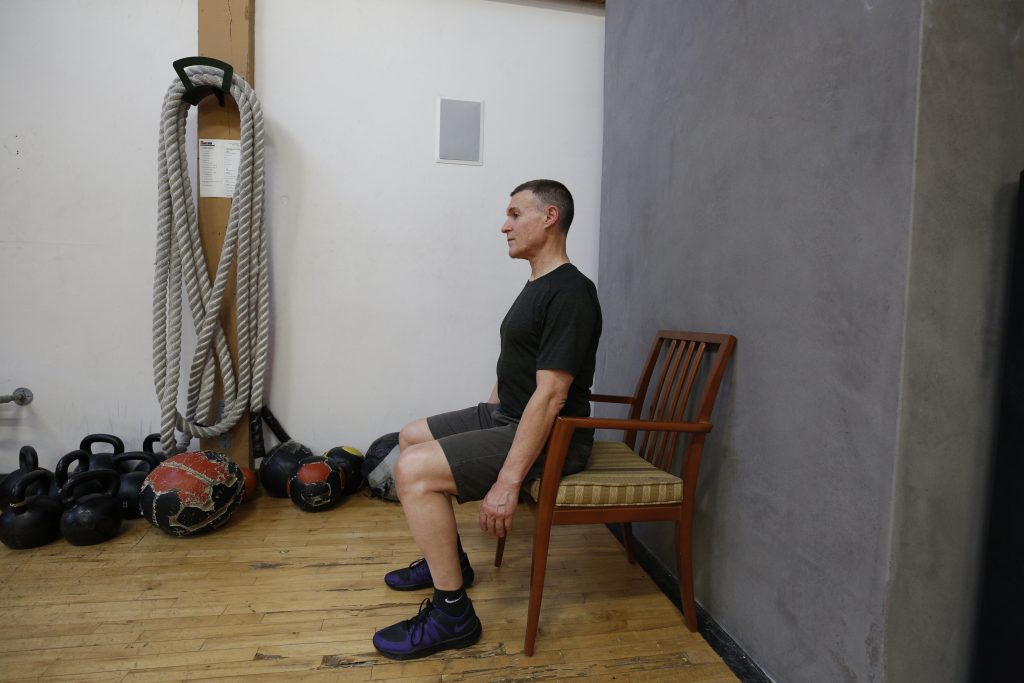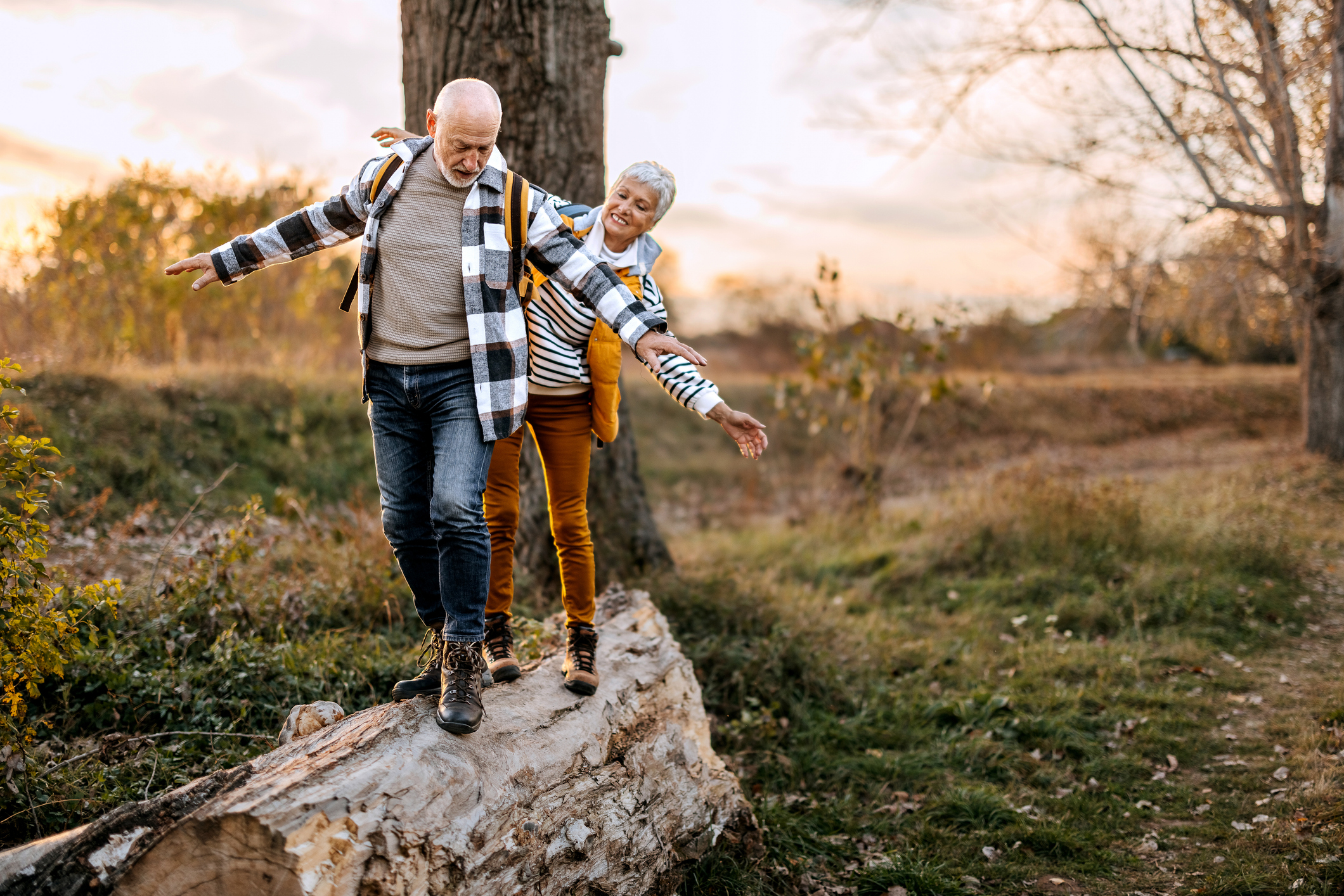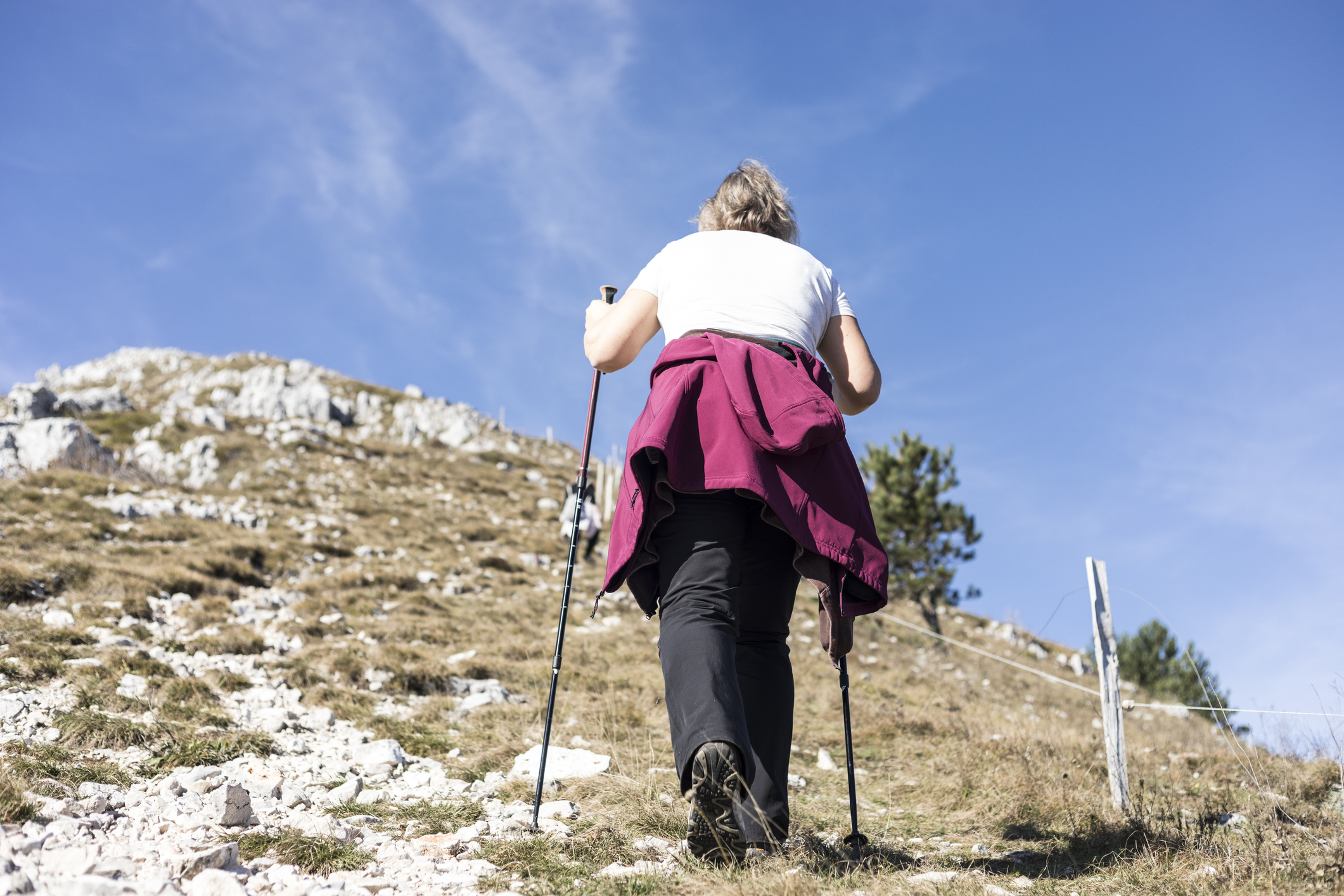SUMMARY: Older adult (OA) falls risk is a perennial concern, so that’s why it’s “Falls…

THE SIT-TO-STAND TRANSITION: AN OLDER ADULT ESSENTIAL
SUMMARY: A capable Sit-To-Stand (STS) transition is essential for older adults (OAs) to have an active & independent life. The STS is also the most important movement pattern for OAs to resistance train to enhance lower body strength, power & muscle. This post covers why it’s absolutely essential for OAs to train the STS; how to assess your current STS ability; the STS mindset & performance components; pitfalls to performing a high-quality STS; and a STS training strategy which is scaled to your current physical ability.
INTRO
October’s first week is promoted as “Active Aging Week” by the International Council on Active Aging, so we need to talk about the number one impediment to active aging: Sarcopenia, the age/disuse-associated loss of strength, power & muscle tissue. People love to talk about protein, but there’s really only one effective remedy to sarcopenia, and that’s sufficiently challenging resistance exercise (1) performed regularly. My post “The Importance of Doing Hard Things” is a good first read, as I discuss the need for OAs to regularly perform physically challenging resistance exercise (RE), which I recommend as the number one “hard thing” all OAs should be doing.
With regard to RE, I’ve been asked a question that goes something like this: “I know I should be doing RE, but I’m ________, so if I only did one RE exercise (movement pattern), what should it be”? The answer is (most often) the STS movement pattern.
Along with walking (2), there is nothing more fundamental than the ability to transition from sitting to standing; these two are the most important physical capabilities if OAs are to maintain their freedom & independence. So, all OAs should make it a priority to focus on training the STS capability since rising up from car seats, couches, chairs, or toilets is an unavoidable fact of physical life.
OAs must maintain or improve the physical elements of strength (3), power (4) and muscular endurance (5), and we train those elements when challenging the STS pattern with RE. The minimal goal is the repeatable physical capability to rise from a standard 17-18” chair, using only the lower body’s strength & power (without the use of one’s arms). And we need to be able to successfully manage the STS transition multiple times consecutively, not just one & done.
It’s super important to train to perform a high-quality, balanced, STS powered concurrently with ALL of your lower body – meaning concurrent use of both thigh (knee joint) & butt (hip joint) strength. This concept comes into focus if you compare a 20-year-old’s STS to a typical octogenarian’s STS: A 20-year-old’s STS is balanced – their chest & hips rise together (torso more vertical with chest always facing more up & out), however an OA’s STS is often quite precariously unbalanced, characterized by thrusting their chest/torso forward (torso more horizontal with chest facing down), with hips rising without any vertical chest lift until the knees are almost straight. Below is a video of a high-quality, balanced STS – notice the hips & torse rise together with chest up:
Watch Video
ASSESSING YOUR STS CAPABILITY
To assess your STS capability, use the 5-times STS Test (5xSTS), a standardized test measuring the time it takes to rise & lower down 5x consecutively. The 5xSTS has normative age group times-to-completion which are discussed after 5xSTS directions below. If you have any doubts about self-administering 5xSTS, consult your Health Care Provider. Here is a full 5xSTS video:
Watch video
5xSTS Directions
- You need a 17/18-inch chair and a timing device
- Sit with your weight on your butt and your feet hip width & flat on the floor
- Cross arms on chest
- Take one practice STS rising from chair to full vertical standing and then lower butt back to chair under control; avoid a free-fall drop back to chair
- If you are unable to rise fully from 17-18” chair, see category “A” section below
- Measure the time it takes to perform 5 strict STS with arms crossed on your chest
- To begin test, have a helper say “go” and simultaneously start clock; if you’re solo, start clock just before your butt lifts off chair for first time
- Helper stops clock when your butt contacts chair for the fifth repetition; same if solo
Interpreting Your 5xSTS Results
Category “A”: Can’t rise from chair with arms crossed on chest using just legs
This category is a physically precarious situation as you’re likely walking with some difficulty and possibly close to losing your independence; you’re also severely under-muscled and lacking in strength/power (sarcopenic); you’re possibly frail or pre-frail by common clinical criteria (6). It’s critically urgent for you to work on improving your strength & power. I would strongly recommend engaging the services of a physical therapist (7) or qualified OA-specialized fitness trainer (8) for the most success. If going it alone, see TRAINING THE STS below.
Category “B”: Can rise from chair at least 1x using only legs, but can’t do 5x consecutively
Category “B” is just a whisper away from Category “A” above. Category “B” OAs possess very little strength/power reserve capacity, which puts them just one illness, injury, fall, surgery or other physical “dis-use event” away from Category “A”. It’s possible you’re frail or pre-frail by common clinical criteria (6). It’s urgent for you to work to improve your strength & power ASAP. I recommend engaging the services of a physical therapist (7) or qualified OA-specialized fitness trainer (8) for best success. If going it alone, see TRAINING THE STS below.
Category “C”: Able to complete the full 5xSTST test with arms crossed on chest – compare your time to age group averages just below and discussion points
5xSTS Age Group Average Times
*60-69 years: Average time= 8.1 seconds; one SD slower time= 11 seconds
*70-79 years: Average time= 10 seconds; one SD slower time= 12.6 to 13 seconds
*80-89 years: Average time= about 11 seconds; one SD slower time= 14 to 14.8 seconds
* 90 years+: Average time= 16.2 seconds; one SD slower time= 22.5 seconds
The quality of your STS matters, so my comments here are incomplete, but think about your 5xSTS time this way:
- A minimally strong/powerful lower body (hips down) would be reflected in times that are better than the average (mean) for your age group.
- The slower your time from the average, the more of a call-to-action & warning sign/caution it is to improve your strength, power and muscle.
- If your time is slower than one standard deviation (SD) from average, this is an extreme warning that action should be taken immediately to improve your strength, power and muscle.
THE STS PERFORMANCE POINTS
1) Mindset: A high-quality STS is characterized by hips & chest moving upward together. It’s about GETTING YOUR BODY TO VERTICAL ASAP WITH AN EXPLOSIVE UPWARD MOTION! You are trying to stack your thighs, hips, and trunk on top of each other as near simultaneously as possible by forcefully straightening your knees and hips. You are ALL-IN for expressing your lower body strength & power!

2) Set Up: Put your feet flat on floor hip-width apart, slightly behind your knees, with toes pointing somewhat straight-ahead. Your visual focus should be UP – that’s the direction you’re intending to go, so tell that to your body with your visual focus – don’t look down. See photo at right for proper set up.
3) Initiation: Start the STS pattern by hinging your trunk forward at your hips; this begins the process of shifting body weight from your butt to your feet. But keep your chest up and try not to overemphasize this action by getting your trunk too horizontal – if your trunk doesn’t stop, you miss the opportunity to transfer useful momentum from trunk to hips to help propel your body upward.
4) Power Drive: Rocket your head toward the ceiling by forcefully straightening your knees and hips together. It can help to think of driving your feet through the floor as you drive your head toward the ceiling – make yourself long, tall & vertical as fast as possible.
STS COMMON PITFALLS & MISTAKES
1) Most common is not spreading feet apart enough, which makes it harder to express your lower body strength, increases the vertical distance to fully straighten your knees & hips, and is less stable.
2) Second most common is not expressing your lower body’s propulsive capability while using help with the arms; meaning, when the arms get involved, OAs often give much less than 100% effort with their legs/hips to fully express their lower body strength & power. If you need to use your arms, remember they are the “dessert” not the “main course”.
3) If your 5xSTS time puts you in Categories “A”, “B”, and slower than 1 SD time for age group, it’s critical you have an intentional performance plan for the STS; you just can’t afford a haphazard approach: The weaker you are, the less margin for error you have, and the more precision, focus & determination you will require.
4) Many OAs overemphasize the trunk-forward action, which results in their trunk getting too horizontal. This approach is NOT recommended, particularly if you have osteoporosis or balance challenges or wish to train the STS pattern for strength & power. See video below of an unbalanced STS where trunk remains too horizontal and hips & chest don’t rise together:
Watch Video
TIPS FOR TRAINING THE STS
It’s always best to get personal instruction from a qualified OA-specialized trainer (8) or physical therapist (7). If you’re going it alone, be sure to seek out & follow the advice of your Health Care Providers. Below are general concepts to help you improve your STS capability, regardless of where you’re starting from.
a) You must scale your STS training to meet your body’s current physical capabilities & issues.
b) Your body weight is the resistance you have to overcome, but it’s difficult to “scale” since it’s a fixed amount– it’s possible to “de-load” some body weight, but not without professional help and specific tools.
c) Adjusting STS seat height is how we scale, but you need to avoid re-enforcing the unbalanced, trunk horizontal version of STS as per the video above, so you need to find a seat height where you can perform STS with chest & hips rising together, and without the aid of your arms. It may require a seat height of as much as 30 inches – you’ll need to find your comfort zone height for your training starting point.
e) Next, you need to know how hard you are challenging yourself with STS training – the intensity of training– which is determined by how many consecutive repetitions (reps) you can perform with good technique, and how many reps you have left in reserve (RIR) once you stop. The fewer reps you are able to perform with a given RIR, the higher the intensity. To begin your STS training, you want to maintain 2-3 RIR while continuously performing at least 5 reps, and preferably 10 reps, with an upper limit of 20 reps. A grouping of consecutive reps is termed a “set” of reps.
f) How many RIR once you stop a set? This is a key concept as you have to challenge yourself sufficiently to create a positive physical adaptation (get better at STS), so having “lots” of RIR once you stop a set will not create a positive physical adaptation because it’s not an intense enough effort. The practical upper limit is 5 RIR, with a sweet spot for adaptation at 2-3 RIR.
g) The number of reps per set, and the total number of sets performed, determine the work volume for a training session. Initially, try to use a seat height which enables you to perform at least 10 repetitions with 2-3 RIR and plan on doing 2 sets, taking as much rest as you need between sets. If you have doubts about anything, just do one set of 10 reps with 2-3 RIR.
h) Monitor how your body reacts to your first training session of 2 sets of 10 reps with 2-3 RIR. If it feels good, repeat the same session in 48 hours. If you have significant delayed-onset muscle soreness (DOMS) in your lower body, wait until it subsides and then perform just one set of 10 reps with 2-3 RIR and, again, monitor your recovery. Add back the second set when your body recovers and feels OK after performing just the one set of reps.
i) Keep to your STS training: Max frequency is every 48 hours (every-other-day); or 3x/week is fantastic; and an absolute minimum 2x/wk to create positive physical adaptation. When your RIR increase beyond 2-3, you’ve got some options: 1) lower seat height slightly as long as it doesn’t affect your technique; add reps (up to 20) until you’re at 2-3 RIR; 3) add a third set at the original seat height. My first choice would be #1, because you’re working on increasing your STS range-of-motion which is useful in real life.
j) The goal is to be able to keep lowering seat height down to 17-18 inches for 2-3 sets of 10 reps with 2-3 RIR. At that point, you aim to add some external resistance by holding some form of weight implement in both hands against your chest – dumbbell, kettlebell, etc. – you could also elect to adopt this strategy before you’re down to 17-18” seat height, as long as you’ve been training for a while and things are going well.
k) Keep training!! Once you’ve been training for a while, you have the option of increasing the intensity (challenge) by using a resistance that you can only complete for 5-9 times with 2-3 RIR. Still look to perform at least 2-3 sets of reps each training session.
l) After training to develop strength for a while, aim to train for power by performing high-velocity STS – you look to explode off the chair and stand up as fast as possible (sit back down slowly). Perform 3-6 reps for 2-4 sets and remember the key point is it’s the intention to move fast that counts, not your absolute speed.
FOOTNOTES:
1) Also called weight training or strength training. The “resistance” to movement can come from elastic bands, cords, dumbbells, barbells, kettlebells, cable/pulley apparatus, or pin-selected weight stack machines as well as body weight in the STS. The “resistance” is often called a “load”.
2) It’s also interesting to note that walking ability (or lack of) runs in parallel with STS ability. If an OA has difficulty with the STS, you can bet they are also struggling with an unsteady & slow gait characterized by short steps – and of course it’s impossible to walk at all if you can’t get out of a chair to begin with…
3) The ability to generate muscular force to overcome, accelerate, support or slow down a load (like our body weight).
4) The ability to generate muscular force quickly – in real life this might be expressed as being able to move our legs or arms quickly.
5) The ability to generate a certain amount of muscular force repeatedly before fatiguing.
6) See Fried’s Frailty Index
7) Ideally, look for a PT who is a Board-Certified Geriatric Clinical Specialist or Ice Physio Certified Older Adult Specialist (also called Modern Management of the Older Adult Certified), note however that these certifications are relatively rare for PT professionals.
8) An appropriately qualified OA trainer should have good general fitness training qualifications as well as specific OA training and certifications. Appropriate general qualifications should be a) hold a degree in exercise science & b) be NSCA CSCS certified; the most important specific OA certifications are a) Ice Physio Certified Specialist: Older Adult (also call Modern Management of the Older Adult Certified); and b) Functional Aging Specialist from the Functional Aging Institute. I have all of these qualifications and more – see here – indeed I was the very first fitness trainer to earn the Ice Physio Certified Specialist Older Adult.



